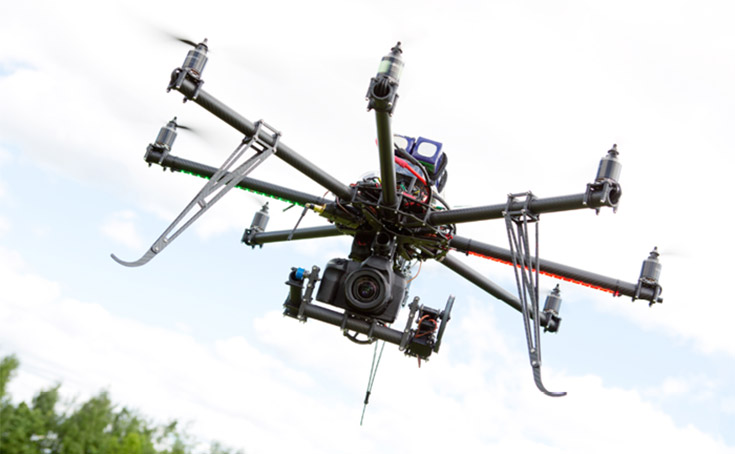Fighting for life: Why drones are infiltrating emergency services
Joshua Potts provides an insight into the increasing use of drones within the emergency services, and in critical situations
This year, a young start-up company wowed the judges of the European Satellite Navigation Competition, beating an array of strong contenders for the grand prize. The Poseidron drone, developed by Sincratech Aeronautics, http://sincratech.com uses thermal imaging and spatial positioning software to find people stranded at sea. It is able to deploy a dinghy for shipwreck survivors, and is equipped with a transmitter to alert rescue teams to their peril. It looks like an orange lily flower, with its octagonal bloom of rotor blades hovering gently in the air. Poseidron is symbolic of the encroaching prevalence of drones on the cutting edge of tech innovation, especially since a drone with built-in software capabilities has carved its mark in a competition usually dominated by satellite relays and GPS platforms.

The Poseidron drone from Sincratech Aeronautics, won the European Satellite Navigation Competition (image: Poseidron)
For some, this may be emblematic of the rise and rise of UAV application in the emergency services. If you are on the frontline of danger, then it makes sense to have a good toolkit to hand – it is hazardous to wade into modern problems without a suitable modern solution. The problems our emergency services face, compounded by belt-tightening in tough economic climates, mean cost-efficiency and intelligence are vital to navigating increasingly crowded cityscapes, coastal regions and disaster-struck rural areas with the thoroughness these environments call for.
Drones are an eye in the sky that serve to compliment ground forces, not banish them entirely. As such, they are being lauded around the world as a user-friendly weapon in the fight against the gravest consequences of human error, natural catastrophe, or plain and simple neglect.
The Nepalese earthquake, for instance, has been a yardstick of sorts for the feasibility of UAVs in disaster zones. Pix4D was among 15 companies that were brought in under the leadership of Patrick Meier for the Mapping Nepal project, in which drones were sent to survey pockets of ruined towns and villages. The effort painted a widescreen picture of the damage and bodes well for home-grown operators being commonplace in countries at risk of similar incidents, disseminating a pool of expert knowledge.
UAVs, though, remain useful for rapid response tasks of all sizes. Utah’s County Sheriff’s office in the US is looking to buy one, mimicking around a dozen UK police forces hopping on the drone bandwagon to further assist their search and rescue capabilities.
In fact, Britain is already becoming an acolyte of emergency drone deployment, with drones hitting local news headlines. Manchester Fire Service has been prolific in its drone activities – a blaze near Victoria station back in October was dealt with swiftly thanks to a new drone model equipped with an infrared camera. The fire department was happy to tweet about its victory, capturing the UAV moments before take-off, its red light pulsing on the tarmac.
Jetliner passengers could see smoke rising from the seven-storey CWS building, so this was a serious deal. Luckily Manchester’s team has round-the-clock drone capabilities and was more than up to the task; other fire and rescue services are following its example across the country, using UAVs to scan for the fiercest parts of a fire without health or visibility issues.
Farther afield, emergency relief in isolated or disused areas is breaking free of timeworn handicaps. Rwanda has been chosen as the first ‘drone port’ for the delivery of medical supplies in 2020 – President Paul Kagame has plans to turn the country’s capital, Kigali, into a real prospect for technology investors. The 1994 genocide left much of the city’s infrastructure in a state of collapse, yet drones are representative of Rwanda’s ascension to normality, helping to carry building materials, vaccines and other precious cargo over the rolling hills that have made the country notoriously difficult to navigate.

Jonathan Ledgard, from the Afrotech initiative, told The Guardian in September: “It is inevitable on a crowded planet, with limited resources, that we will make more intensive use of our sky using flying robots to move goods faster, cheaper and more accurately than ever before.” He is a realist as much as a publicist, acknowledging: “It is not inevitable that these craft or their landing sites will be engineered to be tough and cheap enough to serve poorer communities that can make most use of them.”
The dichotomy between rich and poor, though, does not warrant the exclusion of UAVs, especially since models are becoming cheaper and more efficient as commercial demand drives technical specs to their fullest potential. The scope for drones being used as supply drops will expand radically in the next decade as Remotely Piloted Aircraft Systems (RPAS) become more capable in the long-haul entrustment of heavy goods.
How drones will fit into society comes down to where we locate our priorities. If machines are a reflection of their creator, then their ability to save the imperilled arises from our pursuit of empathy, our willingness to throw our chips behind the right cause when and where the money matters. Hopefully, the sight of an impersonalised robot will bring great joy from those in a danger, a feeling that everything will work out and come right again. And that, readers, is the true marvel of progress.
For more insights into UAVs within emergency services, visit the SkyTech 2016 UAV conference & exhibition taking place in January in London. Further details can be found here
See CRJ 11:2 for an article by Andrew Griffith on Drones in the Emergency Services
Joshua Potts, 04/01/2016